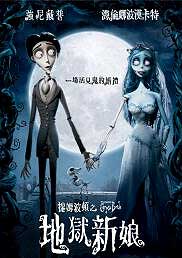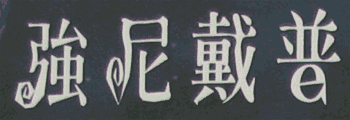 The cover for the DVD for Tim Burton’s Corpse Bride (Dìyù Xīnniáng / 地獄新娘 / “Hell Bride”) has what for me is an arresting usage: the roman letter “e” has been incorporated into a Chinese character.
The cover for the DVD for Tim Burton’s Corpse Bride (Dìyù Xīnniáng / 地獄新娘 / “Hell Bride”) has what for me is an arresting usage: the roman letter “e” has been incorporated into a Chinese character.
![Tim Burton's ['Corpse Bride'] -- in Chinese characters](https://pinyin.info/news/news_photos/2006/03/corpse_bride.gif)
At first I thought this substitution of “e” for the 日 portion of the shì (是) phonetic element of 提 (tí) might be meant as playfully phonetic itself: “Teem” Burton, of sorts.
提姆波頓
Tímǔ Bōdùn
But then I noticed how Johnny Depp’s name was written:

There’s that e again. But this case, the character, 普, which also has its 日 element replaced, doesn’t have a long e sound in its pronunciation:
強尼戴普
Qiángní Dàipǔ
“Daipu”? That sounds like a portmanteau for what’s found in dirty diapers. (Sorry. Couldn’t resist.)
So it was just a case of a designer having fun. The e has no phonetic function here.
But there’s something else interesting about how Johnny Depp’s name is written. The first character, 強, takes more strokes to write in its so-called simplified form than in traditional Chinese characters.
traditional (11 strokes) 強 强 “simplified” (12 strokes)

I found another of the letter “e” appearing in Chinese characters. In this case it is a clever play on words. See a href=”http://davidonformosa.blogspot.com/2006/04/e-in-coffee.html”>my blog for a photo and explanation.
Pingback: David on Formosa » The e in coffee
Pingback: Pinyin news » Blog Archive » S.U.: Surf’s Up
On a related note, the Hong Kong poster for the American movie The Sixth Sense featured a clever use of the symbol “6” in the Chinese title:
http://www.hkfilms.com/Reviews/2000/SixthSense.jpg